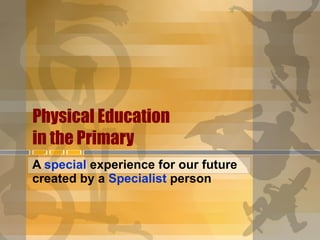Peripatetic Physical Education
- 1. Physical Education in the Primary A special experience for our future created by a Specialist person
- 2. Has the situation been Pathetic? Long queues? Minimal time on task? Lack of variety of tasks? Same structure of lessons ŌĆō stations and lines? Too regimental? No games ŌĆ” no fun?
- 3. The syllabus abcŌĆÖs gymnastics athletics swimming
- 4. The syllabus dance games brain gym fitness
- 5. Topics to be Covered 100 100 100 100 100 100 (28) Total 5 5 5 5 5 5 (2) Swimming 10 10 5 5 Outdoor Education 10 15 20 30 (8) Gymnastics 50 50 50 50 30 Games 15 15 10 5 5 Fitness 5 5 5 5 10 15 (4) Dance 15 15 15 15 5 Athletics 25 50 (14) FUNdamentals Stage 6 End F 5 % Stage 5 End F 3 % Stage 4 End F 1 % Stage 3 End Yr 6 % Stage 2 End Yr 4 % Stage 1 End Yr 2 % Key Stage / Component
- 6. Scheme of work Establish a link between one lesson and the next Give children practical homework. Show them that they are improving Be positive and enthusiastic Have a structure yet be creative and use many different games
- 7. Structure of Lesson Choose a theme ŌĆō have an objective ŌĆō derive games / activities to achieve that objective Global (start with a game) Analytic (identify an aspect to teach / refine / improveŌĆ”.) Global (end up with a game)
- 8. To be successful, you don't have to do extraordinary things. Just do ordinary things extraordinarily well. Play small sided games where children are more active 3v3 is better than 6v6. Avoid the adult game
- 9. No laps no lines no lectures ŌĆ” In (1) player 8 dribbles for the whole 5 minutes. In (2) player 8 dribbles for about 30 seconds in 5 minutes In (1) the player not only works more but works more specifically as 8 dribbles as in game situation and finds space. It is skill not just technique! 2 1
- 10. How to create a progression Simple refers to the starting point of each individual Move from what the individual knows and guide him / her to a higher level. What pupils know may be easy or more difficult but each student has the ability to move on. Simple Complex
- 11. An example of a skill progression Dribble around cones using dominant foot non dominant foot both feet Dribble to a marker and make a fake against a passive opponent against an active opponent with a wide area where to score against an active opponent scoring in a narrow target Simple Complex
- 12. An example of a game progression 3v1 scoring on end line 3v1 scoring in any of two goals 3v1 scoring in a goal 3v1+1 3v1+2 3v2 scoring on end line ŌĆ”
- 13. Lesson needs to Be FUN Have a focus (general aim which is breakable in small objectives) Involve all Allow for differentiation Send children to class having had a wonderful experience Have a 2ŌĆÖ cool down (simple game) which re-establishes arousal levels to normal












